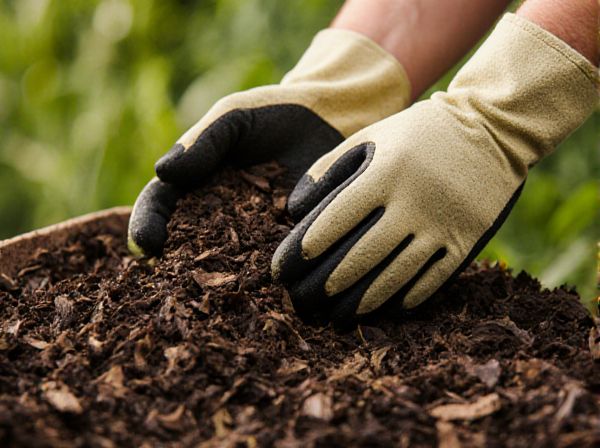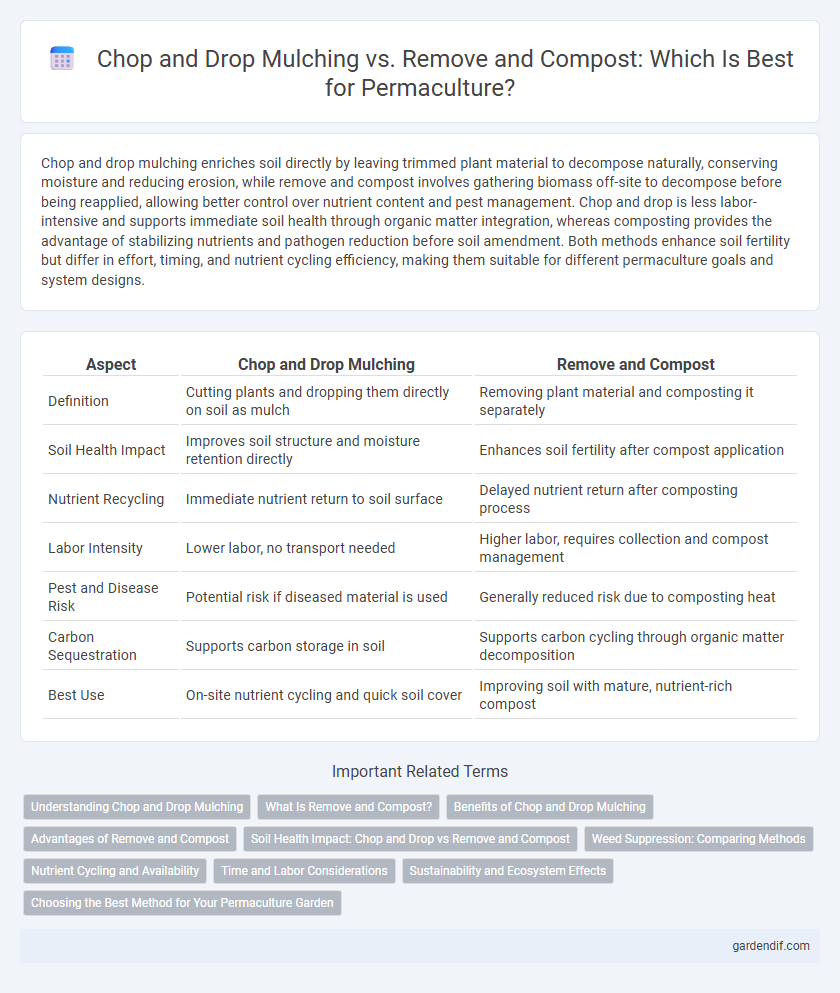
Chop and Drop Mulching vs Remove and Compost Illustration
Chop and drop mulching enriches soil directly by leaving trimmed plant material to decompose naturally, conserving moisture and reducing erosion, while remove and compost involves gathering biomass off-site to decompose before being reapplied, allowing better control over nutrient content and pest management. Chop and drop is less labor-intensive and supports immediate soil health through organic matter integration, whereas composting provides the advantage of stabilizing nutrients and pathogen reduction before soil amendment. Both methods enhance soil fertility but differ in effort, timing, and nutrient cycling efficiency, making them suitable for different permaculture goals and system designs.
Table of Comparison
| Aspect | Chop and Drop Mulching | Remove and Compost |
|---|---|---|
| Definition | Cutting plants and dropping them directly on soil as mulch | Removing plant material and composting it separately |
| Soil Health Impact | Improves soil structure and moisture retention directly | Enhances soil fertility after compost application |
| Nutrient Recycling | Immediate nutrient return to soil surface | Delayed nutrient return after composting process |
| Labor Intensity | Lower labor, no transport needed | Higher labor, requires collection and compost management |
| Pest and Disease Risk | Potential risk if diseased material is used | Generally reduced risk due to composting heat |
| Carbon Sequestration | Supports carbon storage in soil | Supports carbon cycling through organic matter decomposition |
| Best Use | On-site nutrient cycling and quick soil cover | Improving soil with mature, nutrient-rich compost |
Understanding Chop and Drop Mulching
Chop and drop mulching involves cutting plant material and leaving it on the soil surface to decompose naturally, enriching the soil with nutrients and improving moisture retention. This method enhances soil structure by increasing organic matter, promoting beneficial microbial activity, and reducing the need for external inputs in permaculture systems. Unlike remove and compost, chop and drop minimizes labor and carbon footprint by recycling biomass directly in place, accelerating nutrient cycling and fostering sustainable garden ecosystems.
What Is Remove and Compost?
Remove and compost involves cutting plant material and transporting it off-site or to a designated compost area where it decomposes into nutrient-rich organic matter. This method helps control pests and diseases by removing potential breeding grounds and allows for better nutrient cycling when the finished compost is applied back to the soil. In permaculture, remove and compost is often used to manage biomass more precisely and improve soil health through controlled decomposition.
Benefits of Chop and Drop Mulching
Chop and drop mulching enhances soil fertility by directly returning organic matter and nutrients to the planting area, improving moisture retention and reducing erosion. This method supports beneficial soil microorganisms and earthworms, which contribute to healthier soil structure and increased plant growth. It also saves labor and resources by eliminating the need to transport and manage compost piles off-site.
Advantages of Remove and Compost
Remove and compost mulching allows for nutrient-rich organic matter to be broken down in a controlled environment, enhancing soil fertility more effectively than chop and drop methods. This approach reduces the risk of pest and disease carryover by removing plant material from the immediate growing area. Composting also promotes microbial diversity and improves soil structure, leading to healthier and more resilient permaculture systems.
Soil Health Impact: Chop and Drop vs Remove and Compost
Chop and drop mulching enhances soil health by directly recycling organic matter on-site, improving microbial activity, moisture retention, and nutrient cycling. In contrast, removing biomass for composting temporarily extracts nutrients from the soil but produces concentrated, nutrient-rich compost that can be applied strategically. Chop and drop fosters continuous soil cover and reduces erosion, while composting allows precise nutrient management but requires additional labor and time before soil benefits are realized.
Weed Suppression: Comparing Methods
Chop and drop mulching effectively suppresses weeds by creating a dense layer of organic matter that blocks sunlight, reducing weed seed germination and growth. Remove and compost methods can disturb soil and bring buried weed seeds to the surface, potentially increasing weed emergence. Using chop and drop enhances soil health while maintaining a natural weed barrier, making it a preferred strategy for sustainable weed management in permaculture systems.
Nutrient Cycling and Availability
Chop and drop mulching enhances nutrient cycling by allowing organic matter to decompose directly on-site, enriching the soil with readily available nutrients that support plant growth. This method boosts microbial activity and improves soil structure by maintaining a continuous layer of mulch, reducing nutrient leaching compared to the remove and compost method. In contrast, removing plant material for off-site composting can delay nutrient return and may result in nutrient losses during transportation and processing.
Time and Labor Considerations
Chop and drop mulching significantly reduces time and labor by allowing plant material to decompose directly on-site, eliminating the need for collection and transport. Remove and compost requires additional work to gather, move, and monitor organic matter, often slowing down garden maintenance cycles. Choosing chop and drop enhances efficiency in permaculture systems by integrating nutrient recycling with minimal physical effort.
Sustainability and Ecosystem Effects
Chop and drop mulching enhances soil fertility by returning organic matter directly to the ground, promoting microbial activity and reducing erosion in permaculture systems. Removing biomass for composting transfers nutrients offsite, potentially depleting immediate soil nutrients but allowing controlled decomposition that can improve soil health when reapplied. Sustainable permaculture practices favor chop and drop for maintaining ecosystem balance, minimizing waste, and supporting natural nutrient cycles.
Choosing the Best Method for Your Permaculture Garden
Chop and drop mulching enriches soil health by allowing plant matter to decompose naturally on-site, conserving moisture and enhancing microbial activity. Remove and compost offers more control over nutrient cycling and pest management, producing balanced organic matter that can be strategically applied. Selecting the optimal method depends on garden scale, plant types, pest presence, and time availability for maintenance in your permaculture setup.
Chop and Drop Mulching vs Remove and Compost Infographic

 gardendif.com
gardendif.com